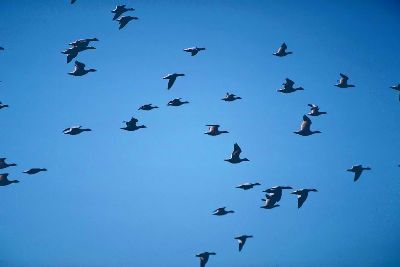by Larry
August, 2005The H5N1 Threat - Updating the Potential for a Viral PandemicIn an essay earlier this year, Are We Ready for the Next Biological Disaster?, I pointed out that the World Health Organization finds credible, worrying evidence of a likely pandemic from the spread of new contagious flu strains to humans, and that we are not prepared. In this piece, I'll focus on just one such possible threat, the H5N1 avian virus, with information available through early this month.
H5N1 is the designation for the quite serious bird flu virus, first noted in southeast Asia, that has been spreading through many species of fowl in recent years and which was also documented to have begun killing people in 2003. Currently, the main threat to humans is among those who are in regular, direct contact with birds once the latter have become infected, but the most concern is with a variation on the strain that may develop and be easily transmittable among our species. So far, there is some indication of human to human spread, but only to a quite limited degree, requiring close interaction and possibly genetic similarity. Thus, members of the same family have come down with the H5N1 flu, even though only one member may have had contact with the birds carrying the virus, but there has so far apparently not been transmission between humans who did not have this association.
Why, then, is there any alarm? The virus tends to be quite susceptible to modification, remaining viable in many of the altered versions. Among the hundreds or thousands of such spontaneous new forms that are occurring within millions of now infected wild and domestic birds, it would require only one mutation, to a virulent strain that could pass easily between people, for the threat of a pandemic to become real. Noting the courses of earlier flu pandemics, scientists believe the H5N1 strain has every potential to generate such a contagious variety, given the huge population of creatures already infected, within which the virus could be modified, and the large number of humans who are regularly handling birds that may be infected. There are a minimum of three plausible avenues for the development of a highly transmittable strain, such as:
By any of these means, a contagious flu variety could evolve at any time from the current H5N1 viral forms. It may have already occurred, today for example, or the threat may not be realized for several years. Nobody knows if or when the potential danger would shift to reality, only that the chances are very good for it to do so. Meanwhile, from initially just being a regional problem in southeast Asia, migration of infected birds has carried the bird flu strain to Russia. Migratory flyways are, in turn, relatively short between Russia and North America, so it is thought that infected birds may be appearing in Canada or the US before much longer. People working with large flocks of turkeys in MN, WI, and elsewhere in our northern areas, may need to be alert to H5N1's showing up among their winged charges. Forms of less deadly avian flu already infect some of our domestic birds, but fortunately not as yet the virulent H5N1 type.
If the feared new strain should develop and get past the low "safe" threshold of human infection, modern society affords many opportunities for its fairly rapid dissemination. Carried from one major population center to another by plane, train, ship, or automobile, within weeks, tens or hundreds of millions could be at risk. Up to now, a large percentage of the humans infected with H5N1 have died. It is not known if a more easily spread form would still be so lethal. With luck, it might be no more harmful than the usual outbreaks of influenza we experience each flu season. But every now and then, such infections turn out to be extremely dangerous. The risks of a quite deadly outbreak should not be minimized. A pandemic is hugely destructive. It would be hard to exaggerate the potential for harm one might cause. Health organizations point out that not enough is being done by local and national governments to get ready for this or another type mass disease spread. Vaccines are still in development, with no assurance they will be ready or effective to deal with a potential pandemic. Nor are systems well in place for the monitoring of or reporting on local cases. Community medical facilities are completely inadequate for a highly lethal and widespread viral incident. Much of the effort to defeat a new influenza virus may depend, then, on precautions at the individual and family level. As in the SARS epidemic, once a pandemic begins, surgical or similar masks could be in great demand. It may be good to stock up early. One's vulnerability to a virulent flu strain could also be reduced by avoiding exposure to large groups of people, taking seasonal flu shots (to limit contracting other viruses that might weaken the immune system), and bolstering the body's ability to fight off fresh diseases by the tried and true basics: adequate rest, plenty of exercise, and maintaining a healthy diet. Come to think of it, most of those would be good ideas even if we were not at risk from a viral pandemic!
Sources: Laurie Garrett: Are We Prepared for Avian Flu? Interviewed by Jim Motavalli in Green Living; July-August 2005 The Threat from Bird Flu. Patrick Dixon in Global Change Avian Flu Hits Russia. Martha Wexler on NPR: All Things Considered; August 3 2005 |

 Experts say it is possible to quarantine victims and so contain the virus if it does become contagious in Homo sapiens, but computer models of such outbreaks suggest the success of these methods depends on the virus being caught quite early, before it has spread to more than a few dozen people. This level of preventative health efficiency was not accomplished when the SARS outbreak occurred a few years ago. There is little indication our methods have improved significantly since then. In the US, we may hope that, as in that instance, the disease is at least able to be largely contained on another continent. Yet with the next threat we may not be so fortunate as with SARS.
Experts say it is possible to quarantine victims and so contain the virus if it does become contagious in Homo sapiens, but computer models of such outbreaks suggest the success of these methods depends on the virus being caught quite early, before it has spread to more than a few dozen people. This level of preventative health efficiency was not accomplished when the SARS outbreak occurred a few years ago. There is little indication our methods have improved significantly since then. In the US, we may hope that, as in that instance, the disease is at least able to be largely contained on another continent. Yet with the next threat we may not be so fortunate as with SARS.